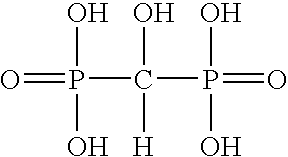Catalyzed air oxidation haircolor
a technology of catalysis and air oxidation, which is applied in the direction of dyeing process, hair cosmetics, textiles and paper, etc., can solve the problems of little color development within the hair structure using this process, poor wear resistance, and inability to achieve good wear resistance, easy to use, and improve the effect of gray coverag
- Summary
- Abstract
- Description
- Claims
- Application Information
AI Technical Summary
Benefits of technology
Problems solved by technology
Method used
Image
Examples
example 16
[0037]
IngredientWT %D.I. Water25.000Isopropanol50.000Sulfuric acid5.0001,2,4-Triacetoxybenzene20.000
Procedure for Preparation of Benzenetriol Solution:
[0038]1) Add of the ingredients into a stainless steel mixing container with agitation in the following order: water, isopropanol, 1,2,4-Triacetoxybenzene, and sulfuric acid.
[0039]2) Heat with a reflux apparatus attached to the top of the vessel to 50° C. for 4 to 6 hours.
[0040]3) Completion of the reaction is signaled by solubility of all dye particles.
[0041]4) Cool the batch to room temp and store in a sealed container.
Procedure for the Preparation of Dye Compositions:
[0042]1) To a jacketed stainless steel batch vessel fitted with a counter rotating crème mixer or propeller mixer, add 90% of the water, and disperse the Ultrez 10 with agitation. Heat the batch to 60-65° C.
[0043]2) Dissolve the antioxidants, etidronic acid, and dyes with mixing.
[0044]3) Prepare a premix using 10% of the water and manganese sulfate. Heat the batch to 5...
PUM
| Property | Measurement | Unit |
|---|---|---|
| viscosity | aaaaa | aaaaa |
| pH | aaaaa | aaaaa |
| pH | aaaaa | aaaaa |
Abstract
Description
Claims
Application Information
 Login to View More
Login to View More - R&D
- Intellectual Property
- Life Sciences
- Materials
- Tech Scout
- Unparalleled Data Quality
- Higher Quality Content
- 60% Fewer Hallucinations
Browse by: Latest US Patents, China's latest patents, Technical Efficacy Thesaurus, Application Domain, Technology Topic, Popular Technical Reports.
© 2025 PatSnap. All rights reserved.Legal|Privacy policy|Modern Slavery Act Transparency Statement|Sitemap|About US| Contact US: help@patsnap.com

